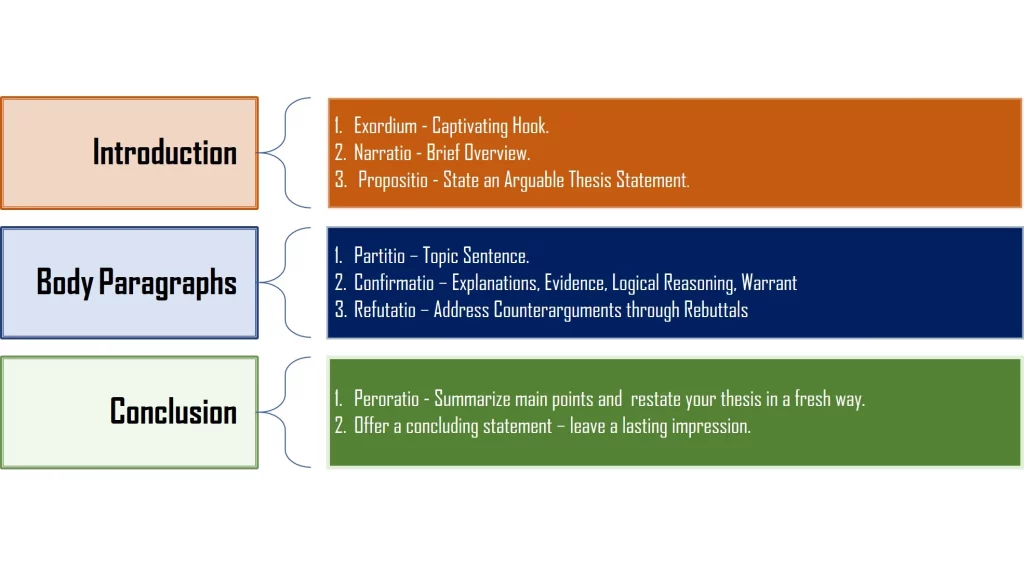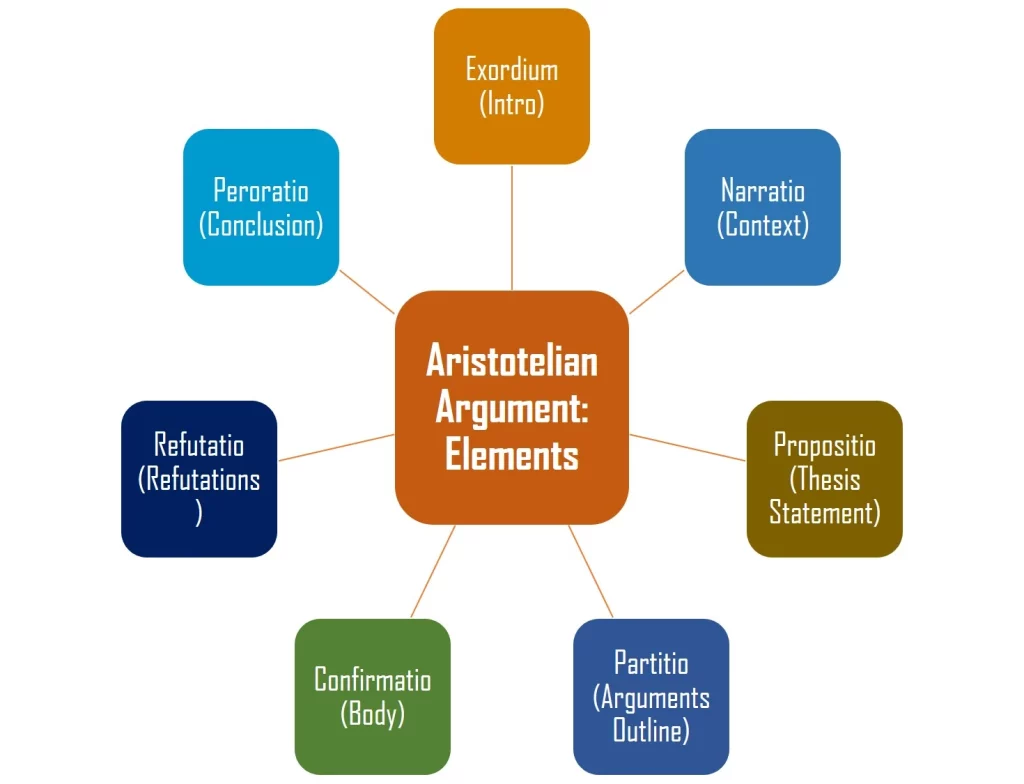- 5-Paragraph Argumentative Essay on Euthanasia
- Aristotelian Argument Essay on Marijuana
- Toulmin Argument Essay on Artificial Intelligence
- Rogerian Argument Essay on Gun Control
- Rebuttal Argument Essay on Renewable Energy
- Sample Historical Argument Essay on the Industrial Revolution
- Literary Argument Essay on 'The Cask of Amontillado'
- Persuasive Argument Essay: Financial Literacy
- Persuasive Argument Essay: Social Media and Politics
- Proposal Argument Essay on Reusable Containers
- Proposal Argument Essay on Workplace Wellness
- Rhetorical Evaluation Argument Essay: MLK's "I Have a Dream"
- Literary Evaluative Argument Essay: "To Kill a Mockingbird"
- Narrative Argument Essay on Resilience
- Definition Argument Essay on Privacy
- Causal Argument Essay on Education

A classical (Aristotelian) argument refers to a traditional form of argumentation that follows the principles and structure outlined by the ancient Greek philosopher Aristotle in his work “Rhetoric.” Aristotle’s approach to argumentation emphasizes logic and persuasive appeals to convince an audience of a particular viewpoint or claim.A classical argument aims to provide a structured and logical presentation of ideas, employing rhetorical strategies such as ethos (credibility), pathos (emotional appeal), and logos (logical appeal) to persuade the audience. This approach is commonly used in persuasive essays, speeches, and debates to effectively communicate and convince others of a particular viewpoint.
Here is a sample classical (Aristotelian) argument essay for college students:
Sample Aristotelian Argument Essay on Marijuana
Other than the Aristotelian approach, argumentative essays can be formulated using the Rogerian argument structure or Toulmin model.
Key Components

Exordium, Narratio, Propositio, Partitio, Confirmatio, Refutatio, and Peroratio are the seven traditional components of a classical or Aristotelian argument. These components provide a structured framework for presenting and developing an argument. Let’s explore each of these components:
- Exordium (Introduction): The exordium is the introductory part of the argument. Its purpose is to capture the audience’s attention, establish rapport, and set the stage for the argument. The speaker or writer may use various techniques such as a captivating story, a thought-provoking question, or an engaging anecdote to grab the audience’s interest and create a favorable disposition towards the argument.
- Narratio (Narration): The narratio provides background information and context for the argument. It involves presenting the facts, explaining the situation, and establishing the scope of the issue being discussed. The goal is to ensure that the audience understands the relevant background and is well-informed about the topic at hand.
- Propositio (Thesis Statement): The propositio states the main claim or thesis of the argument. It clearly articulates the speaker or writer’s position on the issue. The propositio should be concise, specific, and debatable to engage the audience and generate interest in the subsequent argumentation.
- Partitio (Outline of Arguments): The partitio provides an outline or preview of the main arguments that will be presented in support of the thesis. It serves as a roadmap for the audience, indicating the structure and organization of the argument. The partitio allows the audience to anticipate the forthcoming points and mentally prepare for the discussion.
- Confirmatio (Confirmation): The confirmatio is the central part of the argument where the speaker or writer presents the main supporting evidence, reasons, and arguments to substantiate the thesis statement. This section includes logical reasoning, empirical evidence, examples, expert opinions, and other forms of persuasive evidence to convince the audience of the validity and strength of the claim.
- Refutatio (Refutation): The refutatio addresses counterarguments or opposing viewpoints to the thesis statement. It anticipates and addresses potential objections or criticisms that the audience may have. The speaker or writer refutes these counterarguments by providing counter-evidence, alternative explanations, or logical reasoning to demonstrate the superiority of their position.
- Peroratio (Conclusion): The peroratio is the concluding part of the argument. It summarizes the main points, reinforces the thesis statement, and leaves a lasting impression on the audience. The speaker or writer may appeal to the emotions, restate key arguments, offer a call to action, or leave the audience with a memorable closing statement.
These seven components work together to provide a comprehensive and persuasive argumentation structure following the Aristotelian tradition. While not every argument necessarily includes all seven components, they serve as a useful guideline for constructing effective and organized arguments.
General Outline
- Introduction:
- Body Paragraphs (3 or more):
- Conclusion:
How to Write: Steps
- Choose a Controversial Topic: Select a topic that is debatable and has two or more opposing sides. Ensure that you are genuinely interested in the subject matter, as it will make the writing process more engaging.
- Research Your Topic: Conduct thorough research to gather evidence, facts, and information related to your chosen topic. This step is crucial in building a strong argument with credible support.
- Create an Outline: Develop a clear and organized outline for your essay. Your outline should include the following sections:
- Write the Introduction:
- Develop Body Paragraphs:
- Address Counterarguments:
- Write the Conclusion:
- Revise and Edit:
- Seek Feedback:
- Finalize Your Essay:
Remember that the classical argument essay aims to persuade and engage the audience by presenting a clear and well-supported argument. Effective use of evidence, addressing counterarguments, and a persuasive conclusion are key to the success of this essay format.
Developing a Strong Thesis Statement
Here’s a template you can use to craft a suitable thesis statement for a Classical/Aristotelian argument essay:
Through a careful examination of [topic], this essay argues that [claim/position], supported by [main argument 1], [main argument 2], and [main argument 3], ultimately establishing the validity and strength of [claim/position].
Here is a discussion of this template:
- [Topic]: Identify the topic or issue you will be discussing in your essay.
- [Claim/Position]: Clearly state your main claim or position on the topic.
- [Main Argument 1], [Main Argument 2], [Main Argument 3]: Present the main arguments or reasons that support your claim or position. These arguments will form the body paragraphs of your essay, each focusing on a specific argument.
- [Validity and Strength of Claim/Position]: Indicate that your essay will demonstrate the validity and strength of your claim or position by providing evidence, examples, and logical reasoning.
Remember, the thesis statement should be specific, arguable, and provide a clear direction for the rest of your essay. Adapt the template above to fit the specific topic and arguments you will be presenting in your Aristotelian argument essay.
Suitable Topics & Thesis Statements Examples
- Topic: The Role of Government in Promoting Welfare:
Thesis Statement: “This essay argues that an active and responsible government, which provides social safety nets and promotes equitable opportunities, is essential for the overall well-being and progress of society.”
- Topic: Ethical Considerations of Animal Testing:
Thesis Statement: “By examining the ethical implications and potential alternatives, this essay asserts that a balance must be struck between scientific progress and the humane treatment of animals in order to ensure ethical research practices.”
- Topic: The Importance of Arts Education in Schools:
Thesis Statement: “This essay advocates for the inclusion of arts education in schools, emphasizing its vital role in fostering creativity, critical thinking, and well-rounded personal development.”
- Topic: The Benefits of Physical Education in Schools:
Thesis Statement: “By highlighting the positive impacts on physical and mental health, academic performance, and overall well-being, this essay supports the incorporation of physical education as an integral part of the school curriculum.”
- Topic: The Role of Technology in Education:
Thesis Statement: “This essay argues that technology, when used effectively, enhances educational experiences, promotes interactive learning, and prepares students for the demands of the modern world.”
- Topic: The Ethics of Genetic Engineering:
Thesis Statement: “By analyzing the ethical implications and potential benefits, this essay contends that responsible and regulated genetic engineering practices can contribute to advancements in medicine, agriculture, and overall human welfare.”
- Topic: The Importance of Critical Thinking in Education:
Thesis Statement: “This essay asserts that fostering critical thinking skills in education is crucial for cultivating independent thought, informed decision-making, and intellectual growth.”
- Topic: The Impact of Social Media on Society:
Thesis Statement: “By examining the effects on mental health, interpersonal relationships, and the dissemination of information, this essay explores the complex influence of social media on society and advocates for responsible usage.”
- Topic: The Necessity of Financial Education in Schools:
Thesis Statement: “This essay argues that incorporating financial education into the school curriculum is essential for equipping students with the necessary skills and knowledge to make informed financial decisions throughout their lives.”
- Topic: The Benefits of Multilingual Education:
Thesis Statement: “By highlighting cognitive, cultural, and professional advantages, this essay supports the implementation of multilingual education programs that promote linguistic diversity and global understanding.”
- Topic: The Role of Government in Regulating Internet Privacy:
Thesis Statement: “This essay argues that government regulation of internet privacy is essential to protect individuals’ personal information, prevent abuses by corporations, and uphold citizens’ right to privacy in the digital age.”
- Topic: The Benefits of Renewable Energy Sources:
Thesis Statement: “By examining environmental sustainability, economic advantages, and energy security, this essay supports the widespread adoption of renewable energy sources as a viable solution to address climate change and meet future energy demands.”
- Topic: The Impacts of Advertising on Consumer Behavior:
Thesis Statement: “This essay explores the effects of advertising on consumer behavior, highlighting the persuasive techniques employed, ethical considerations, and the importance of informed consumer decision-making.”
- Topic: The Importance of Preserving Cultural Heritage:
Thesis Statement: “By emphasizing the cultural, historical, and educational value, this essay asserts that the preservation of cultural heritage is crucial for identity formation, intergenerational understanding, and promoting a diverse and inclusive society.”
- Topic: The Ethics of Artificial Intelligence:
Thesis Statement: “By examining the ethical implications and potential risks, this essay argues that ethical frameworks and responsible governance are necessary to guide the development and deployment of artificial intelligence technologies.”
Remember, the key to writing a successful classical argument essay is to present a clear and persuasive argument that is supported by credible evidence, addresses counterarguments, and engages the reader.
